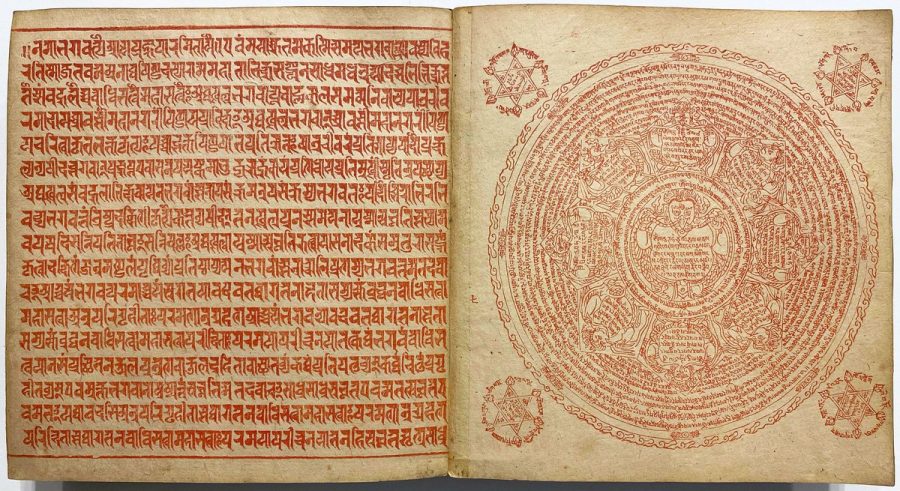
The Gutenberg Bible went to press in the year 1454. We now see it as the first piece of mass media, printed as it was with the then-cutting-edge technology of metal movable type. But in the history of aesthetic achievements in book-printing, the Gutenberg Bible wasn’t without its precedents. To find truly impressive examples requires looking in lands far from Europe: take, for instance, this “Sino-Tibetan concertina-folded book, printed in Beijing in 1410, containing Sanskrit dhāranīs and illustrations of protective mantra-diagrams and deities, woodblock-printed in bright red ink on heavy white paper,” whose “breathtakingly detailed printing” predates Gutenberg by 40 years.

That description comes from a Twitter user called Incunabula (a term referring to early books), a self-described bibliophile and rare book collector who posts about “the history of writing, and of the book, from cave painting to cuneiform tablet to papyrus scroll to medieval codex to Kindle.”
Incunabula’s six-tweet thread on this early 15th-century Sino-Tibetan book includes both pictures and descriptions of this remarkable artifact’s interior and exterior.

Its text, written in the Tibetan and Nepalese Rañjanā script, “is printed twice, once on each side of the paper, so that the book may be read in the Indo-Tibetan manner by turning the pages from right to left or in Chinese style by turning from left to right.” The book’s content is “a sequence of Tibetan Buddhist recitation texts,” or chants, all “protected at front and back by thicker board-like wrappers,” each “covered in fine pen-drawings in gold paint on black of 20 icons of the Tathāgatas.”

Incunabula has also posted extensively about Buddhist texts from other times and lands: a Thai folding manuscript from the mid-19th century telling of a monk’s journeys to heaven and hell; a Mongolian manuscript from the same period that translates the Čoyijod Dagini, “a popular Buddhist text about virtue, sin and the afterlife”; an example of “Japanese Buddhist printing 150 years before Gutenberg”; an “8th century Khotanese amuletic scroll from the Silk Road.” The creators of these texts would have meant the words they were preserving to survive them — but our marveling at them hundreds, even more than a thousand years later, would surely have come as a surprise.

Related Content:
The World’s Largest Collection of Tibetan Buddhist Literature Now Online
Free Online Course: Robert Thurman’s Introduction to Tibetan Buddhism (Recorded at Columbia U)
Tibetan Musical Notation Is Beautiful
Oxford University Presents the 550-Year-Old Gutenberg Bible in Spectacular, High-Res Detail
Based in Seoul, Colin Marshall writes and broadcasts on cities, language, and culture. His projects include the book The Stateless City: a Walk through 21st-Century Los Angeles and the video series The City in Cinema. Follow him on Twitter at @colinmarshall, on Facebook, or on Instagram.


Well, it would be interesting to know how the “printed in Beijing in 1410” was determined: is there an “imprint”? Then another Chinese invention, if it were not preceded by 28 years (1377) from a collection of Buddhist teachings printed in Korea. The source is always “Open culture”
Gutenberg did not invent printing. He invented moveable type. Printing using carved blocks is very old.
You are right, Deborah.
Wood block prints were prominent in China and Japan long before Gutenberg invented moveable type.
This is surprisingly similar to the Ram Dass’ Be Here Now.
The 1410 kanjur was pri in Nanjing, not Beijing! And, yes, it was printed upon dem.
non posso confermare ma magari chi vede provvede … sono in biblioteca … ancor grazie che ci sia … mi è andata sia bene che male …
grazie (ciao shi hen yi)